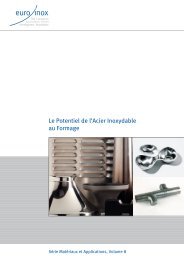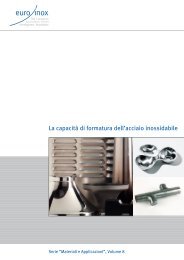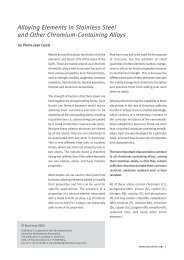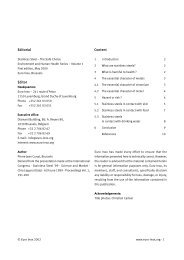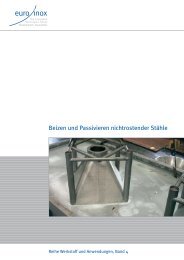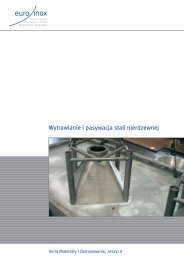Innovative Stainless Steel Applications in transport ... - Euro Inox
Innovative Stainless Steel Applications in transport ... - Euro Inox
Innovative Stainless Steel Applications in transport ... - Euro Inox
You also want an ePaper? Increase the reach of your titles
YUMPU automatically turns print PDFs into web optimized ePapers that Google loves.
2400 N. Thus, the specified fatigue load was 3000 N ± 600 N applied to an area of<br />
100 × 100 mm 2 for 10 7 cycles at a maximum frequency of 100 Hz.<br />
5.2.1 Four-po<strong>in</strong>t bend test<strong>in</strong>g of full-size panels<br />
The bend<strong>in</strong>g tests were carried out <strong>in</strong> a customisable load frame, us<strong>in</strong>g two separate<br />
load<strong>in</strong>g cyl<strong>in</strong>ders and displacement control. The forces were measured directly from the<br />
hydraulic cyl<strong>in</strong>ders and the displacements from both the top and bottom panel surfaces.<br />
The bend<strong>in</strong>g tests were carried out us<strong>in</strong>g displacement control at a speed of<br />
~ 3 mm/m<strong>in</strong>. Details of the test arrangements can be found <strong>in</strong> Figure 59.<br />
Figure 59. Details of panels <strong>in</strong> the four-po<strong>in</strong>t bend<strong>in</strong>g test, show<strong>in</strong>g a) top-sheet wr<strong>in</strong>kl<strong>in</strong>g<br />
under compressive load and b) failure caused by local buckl<strong>in</strong>g of the core element.<br />
Altogether, 18 full-size panels were tested by four-po<strong>in</strong>t bend<strong>in</strong>g. Apart from the<br />
maximum load<strong>in</strong>g force and the correspond<strong>in</strong>g displacements, an effort was also made<br />
to evaluate the yield<strong>in</strong>g behaviour of the panels. Determ<strong>in</strong><strong>in</strong>g a reliable and common<br />
yield criterion for all the panels proved too difficult, however, ma<strong>in</strong>ly because the<br />
scatter orig<strong>in</strong>at<strong>in</strong>g from the distortion of the panels after weld<strong>in</strong>g was too great. Instead,<br />
the slope of the elastic region of each force-displacement curve was def<strong>in</strong>ed, to ga<strong>in</strong> at<br />
least a rough estimate of the elastic behaviour of various panel types under load<strong>in</strong>g.<br />
An effort was made to evaluate the elastic behaviour of the panels, by determ<strong>in</strong><strong>in</strong>g the<br />
slope of the load-displacement curve of each panel at the elastic region. Both panel<br />
types show – with<strong>in</strong> reasonable scatter – approximately the same slope, which depends<br />
ma<strong>in</strong>ly on the thickness of the bottom sheet. Increas<strong>in</strong>g the thickness from 1.2 mm to<br />
1.5 mm results <strong>in</strong> a 15 - 20 % higher slope value. It is also noteworthy that the scatter is<br />
less for the thicker, bottom-sheet panels. In the theoretical panel-optimisation<br />
calculations, the decrease <strong>in</strong> displacement caused by the change of bottom-sheet<br />
thickness from 1.0 mm to 1.5 mm is 17.5 % and 18.4 % respectively for the O- and Vfpanels<br />
(i.e. comparable to the experimental results).<br />
97








